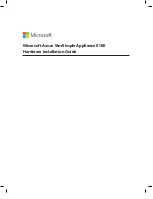
C141-E054-02EN
2 - 10
(1)
Signal Interchanges on the FC Loop
a. Acquisition of loop use rights
The IDD performs arbitration with the other devices on the loop in order to use the loop.
Arbitration is accomplished by setting its own ALPA in the ARB primitive and outputting
it in the form ARB (ALPA, ALPA).
Other devices connected to the loop output the ARB primitive they have received as the
CFW (Current Fill Word) as long as they have no requests.
If the ARB (ALPA, ALPA) travels around the loop and returns to the device which output
it, then that device acquires the loop use rights.
b. Establishing connections with the destination device where data are to be transferred
A device which has acquired loop use rights outputs the OPN primitive to establish
connections with the destination device where data are to be transferred.
Ordinarily, many of the OPN primitives that are used are of two types, Full Duplex Open
and Half Duplex Open, and are distinguished by the ALPA which sets the OPN primitive.
Full Duplex Open: OPN (ALPD, ALPS)
ALPD = ALPA of destination device where data are to be transferred.
ALPS = ALPA of source device which is transferring data.
Half Duplex Open: OPN (ALPD, ALPD)
ALPD = ALPA of destination device where data are to be transferred.
ALPS = ALPA of source device which is transferring data.
This IDD responds to the OPN primitive when received by both Full and Half Duplex
communications, but the OPN primitive issued by this IDD is sent by only Half Duplex
Open communications.
The device that receives the OPN primitive sends the R_RDY primitive if there is
allowance for storage of frames in its Buffer and informs the transfer source device that
reception is possible.
If the transfer destination device cannot receive, it sends the CLS primitive. The transfer
source device receives the CLS primitive, then it resends the CLS primitive and releases its
loop use rights.
In the case of a device which uses Full Duplex Open, while connections are established,
since it is possible to receive other frames from the transfer destination device, it can send
the OPN primitive, followed by the R_RDY primitive to newly inform the source device
that reception is possible and that data equal in volume to its buffer size can be output. (In
the example, it shows that it is possible for it to receive 2 frames and outputs two R_RDY
primitives.)
c. Frame Transfer
The transfer source device, by receiving the R_RDY primitive, can judge that it is possible
for the transfer destination device to receive frames, so, it can send frames.
Summary of Contents for MAA3182FC Series
Page 5: ...This page is intentionally left blank ...
Page 9: ...viii C141 E054 02EN This page is intentionally left blank ...
Page 11: ...This page is intentionally left blank ...
Page 21: ...This page is intentionally left blank ...
Page 131: ...This page is intentionally left blank ...
Page 143: ...This page is intentionally left blank ...
Page 311: ...This page is intentionally left blank ...
Page 313: ...This page is intentionally left blank ...
Page 324: ...This page is intentionally left blank ...
Page 327: ......
















































